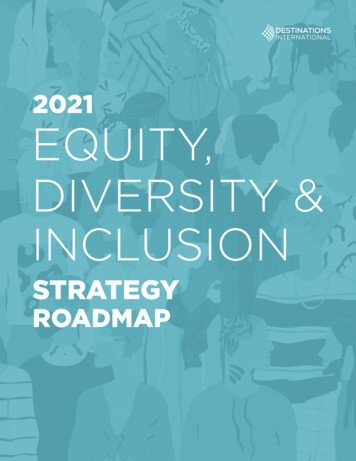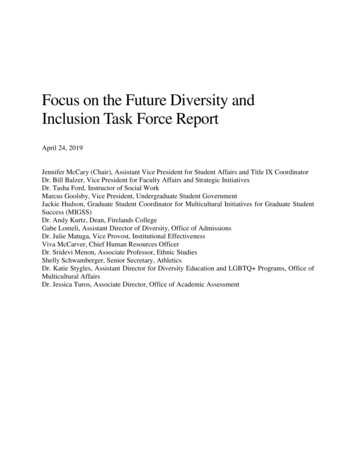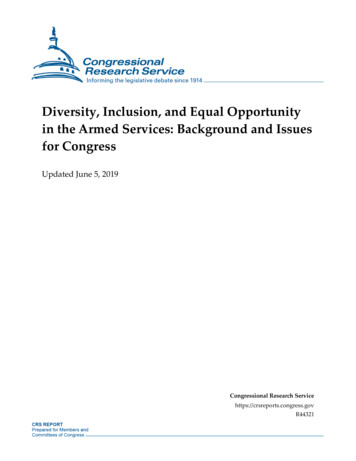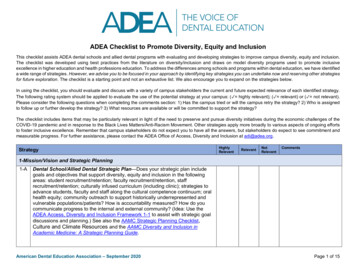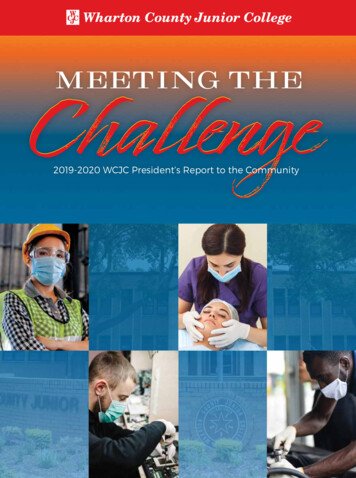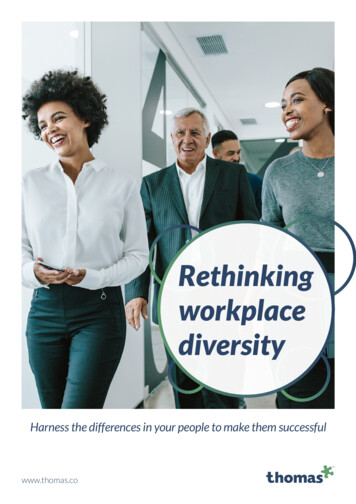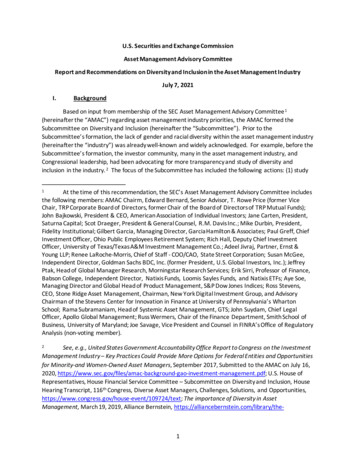
Transcription
U.S. Securities and Exchange CommissionAsset Management Advisory CommitteeReport and Recommendations on Diversity and Inclusion in the Asset Management IndustryJuly 7, 2021I.BackgroundBased on input from membership of the SEC Asset Management Advisory Committee 1(hereinafter the “AMAC”) regarding asset management industry priorities, the AMAC formed theSubcommittee on Diversity and Inclusion (hereinafter the “Subcommittee”). Prior to theSubcommittee’s formation, the lack of gender and racial diversity within the asset management industry(hereinafter the “industry”) was already well-known and widely acknowledged. For example, before theSubcommittee’s formation, the investor community, many in the asset management industry, andCongressional leadership, had been advocating for more transparency and study of diversity andinclusion in the industry. 2 The focus of the Subcommittee has included the following actions: (1) studyAt the time of this recommendation, the SEC’s Asset Management Advisory Committee includesthe following members: AMAC Chairm, Edward Bernard, Senior Advisor, T. Rowe Price (former ViceChair, TRP Corporate Board of Directors, former Chair of the Board of Directors of TRP Mutual Funds);John Bajkowski, President & CEO, American Association of Individual Investors; Jane Carten, President,Saturna Capital; Scot Draeger, President & General Counsel, R.M. Davis Inc.; Mike Durbin, President,Fidelity Institutional; Gilbert Garcia, Managing Director, Garcia Hamilton & Associates; Paul Greff, ChiefInvestment Officer, Ohio Public Employees Retirement System; Rich Hall, Deputy Chief InvestmentOfficer, University of Texas/Texas A&M Investment Management Co.; Adeel Jivraj, Partner, Ernst &Young LLP; Renee LaRoche-Morris, Chief of Staff - COO/CAO, State Street Corporation; Susan McGee,Independent Director, Goldman Sachs BDC, Inc. (former President, U.S. Global Investors, Inc.); JeffreyPtak, Head of Global Manager Research, Morningstar Research Services; Erik Sirri, Professor of Finance,Babson College, Independent Director, Natixis Funds, Loomis Sayles Funds, and Natixis ETFs; Aye Soe,Managing Director and Global Head of Product Management, S&P Dow Jones Indices; Ross Stevens,CEO, Stone Ridge Asset Management, Chairman, New York Digital Investment Group, and AdvisoryChairman of the Stevens Center for Innovation in Finance at University of Pennsylvania’s WhartonSchool; Rama Subramaniam, Head of Systemic Asset Management, GTS; John Suydam, Chief LegalOfficer, Apollo Global Management; Russ Wermers, Chair of the Finance Department, Smith School ofBusiness, University of Maryland; Joe Savage, Vice President and Counsel in FINRA’s Office of RegulatoryAnalysis (non-voting member).1See, e.g., United States Government Accountability Office Report to Congress on the InvestmentManagement Industry – Key Practices Could Provide More Options for Federal Entities and Opportunitiesfor Minority-and Women-Owned Asset Managers, September 2017, Submitted to the AMAC on July 16,2020, stment-management.pdf; U.S. House ofRepresentatives, House Financial Service Committee – Subcommittee on Diversity and Inclusion, HouseHearing Transcript, 116th Congress, Diverse Asset Managers, Challenges, Solutions, and /109724/text; The importance of Diversity in AssetManagement, March 19, 2019, Alliance Bernstein, https://alliancebernstein.com/library/the21
the current state of diversity and inclusion in the industry, as well as the impact of the lack of diversityand inclusion; (2) gain informed perspective on investor interest in diversity matters, as it pertains toinvestor (and/or investment consultant) selection of asset management firms and investment products;(3) consider investor need for transparency regarding matters of diversity and the ease or challengeassociated with access to reliable disclosure; and, ultimately, (4) consider whether Commission action inthis area would benefit the investing public, the industry at large, and the public markets. As theSubcommittee’s work progressed over the last year, a refined focus was made to identify areas whereincreased transparency on matters of diversity and inclusion would have specific benefit relative toinvestors’ description of what is “material” to their selection of investment advisers and investmentfunds. The AMAC remains dedicated to focusing recommendations on matters directly germane to theCommission’s mission, which it believes includes investor protection, market fairness, andencouragement of a market environment that is worthy of public trust. The AMAC approached thiswork with an earnest dedication to serve the investing public, the industry, and other securities marketparticipants.II.AMAC’s Study of Diversity and InclusionOver the course of many months and countless hours, the AMAC has gathered and studied dataand convened panels of experts in public forums. The quantitative data on the lack of diversity andinclusion, the qualitative “human” side of experiences shared by women and people of color in theindustry, and the call by investors for more transparency on diversity, were all compelling(independently and collectively). A truly brief summary of what we learned is represented below.A.The Statistics Are Startling and Tell a Clear StoryOf the 70 trillion in global financial assets under management (hereinafter “AUM”) across theinvestment universe, less than 1% are managed by minority-owned or women-owned firms. 3Independent from AUM, across the industry of asset management firms, percentages of ownershipinterests by women and people of color in asset management firms remains startlingly anddisproportionately low, by any and every objective measure. 4 Women and people of color also htm; When Will We See More Diversity in Investing,Harvard Business Review, May 25, 2019; Understanding Diversity and Inclusion in the Investmentmanagement Industry, The Diversity Project, PwC, March 2018, See United States Government Accountability Office Report to Congress on the InvestmentManagement Industry – Key Practices Could Provide More Options for Federal Entities and Opportunitiesfor Minority-and Women-Owned Asset Managers, September 2017, Submitted to AMAC on July 16,2020, stment-management.pdf.3See also Study: Race Influences Professional Investors’ Financial Judgments, Lyons-Pedia et. al., StanfordUniversity, May 2019, Submitted to AMAC on July 16, 2020, es.pdf.See Diverse Asset Managers Initiative Investment Consultant Survey & Report 2018, RabenGroup, Submitted to AMAC on July 16, 2020, t42
dramatically underrepresented (by all objective measures) at the board and senior management levelswithin asset management firms and fund complexes. 5 This severe underrepresentation also extends togeneral employment within the industry. 6managers-initiative-2018.pdf; Diverse Asset Managers Initiative Investment Consultant Survey & Report2019, Raben Group, Submitted to AMAC on July 16, 2020, -managers-initiative-2019.pdf; United States Government Accountability Office Report toCongress on the Investment Management Industry – Key Practices Could Provide More Options forFederal Entities and Opportunities for Minority-and Women-Owned Asset Managers, September 2017,Submitted to AMAC on July 16, 2020, stmentmanagement.pdf; Diversity of Asset Managers in Philanthropy, Global Economics Group, KnightFoundation, February 2020, submitted to AMAC on July 16, 2020, asset-managers-in-phil.pdf; 2018 Diverse Asset Management Firm Assessment,Josh Lerner, Harvard Business School & Bella Private Markets, January 2019, submitted to AMAC on July16, 2020, e-asset-management.pdf.See also Testimony of Robert Raben, Raben Group, before the AMAC, July 16, pdf; Testimony of Juan Martinez, Knight Foundation,before the AMAC, July 16, 2020, https://sec.gov/files/amac-071620-transcript.pdf; Testimony of SolangeBrooks, New America Alliance, before the AMAC, July 16, 2020, https://sec.gov/files/a.mac-071620transcript.pdf; Testimony of Ron Parker, National Association of Securities Professionals, before theAMAC, July 16, 2020, https://sec.gov/files/amac-071620-transcript.pdf; Testimony of Brenda Chai,before the AMAC, Associations of Asian American Investment Professionals, July 16, pdf; Testimony of Bob Greene, National Association ofInvestment companies, before the AMAC, July 16, 2020, e Diverse Asset Managers Initiative Investment Consultant Survey & Report 2018, RabenGroup, Submitted to AMAC on July 16, 2020, tmanagers-initiative-2018.pdf; Diverse Asset Managers Initiative Investment Consultant Survey & Report2019, Raben Group, Submitted to AMAC on July 16, 2020, -managers-initiative-2019.pdf. United States Government Accountability Office Report toCongress on the Investment Management Industry – Key Practices Could Provide More Options forFederal Entities and Opportunities for Minority-and Women-Owned Asset Managers, September 2017,Submitted to AMAC on July 16, 2020, stmentmanagement.pdf.5See Diverse Asset Managers Initiative Investment Consultant Survey & Report 2018, RabinGroup, Submitted to AMAC on July 16, 2020. tmanagers-initiative-2018.pdf; See Diverse Asset Managers Initiative Investment Consultant Survey &Report 2019, Rabin Group, Submitted to AMAC on July 16, 2020. -managers-initiative-2019.pdf.63
B. Active Discrimination Exists and Remains a Barrier for Minority-and Women-Owned FirmsStudies that the AMAC believes are from credible and objective sources find widespread genderand racial bias in the decisions by those in positions making asset and asset manager allocation decisionsregarding who manages money for governments, universities, charities, foundations, and theinstitutional market in general. 7 Credible studies also show that artificial barriers that do not advancethe interests of investors have been constructed and are being utilized by asset allocators under theguise of fiduciary considerations. 8 The AMAC believes that, considering the critical role of assetallocators in setting priorities on how capital is distributed, the implications of these stark gender andracial disparities are concerning and adverse to the interests of the public markets at large.See Study: Race Influences Professional Investors’ Financial Judgments, Lyons-Pedia et. al.,Stanford University, May 2019, Submitted to AMAC on July 16, 2020, es.pdf. 2018 Diverse Asset Management Firm Assessment, Josh Lerner,Harvard Business School & Bella Private Markets, January 2019, submitted to AMAC on July 16, iverse-asset-management.pdf; Intolerance of Failure –Evidence From U.S. Private Equity, January 2019, Josh Lerner, Harvard Business School & Bella PrivateMarkets, nce-of-failure.pdf;7See United States Government Accountability Office Report to Congress on the InvestmentManagement Industry – Key Practices Could Provide More Options for Federal Entities and Opportunitiesfor Minority-and Women-Owned Asset Managers, September 2017, Submitted to AMAC on July 16,2020, stment-management.pdf; 2018 DiverseAsset Management Firm Assessment, Josh Lerner, Harvard Business School & Bella Private Markets,January 2019, submitted to AMAC on July 16, 2020, -asset-management.pdf; Intolerance of Failure – Evidence From U.S. Private Equity, January 2019,Josh Lerner, Harvard Business School & Bella Private Markets, ce-of-failure.pdf.8See also, Testimony of Robert Raben, Raben Group, before the AMAC, July 16, pdf; Testimony of Juan Martinez, Knight Foundation,before the AMAC, July 16, 2020, https://sec.gov/files/amac-071620-transcript.pdf; Testimony ofSolange Brooks, New America Alliance, before the AMAC, July 16, 2020. https://sec.gov/files/amac071620-transcript.pdf; Testimony of Ron Parker, National Association of Securities Professionals, beforethe AMAC, July 16, 2020, https://sec.gov/files/amac-071620-transcript.pdf; Testimony of Brenda Chai,before the AMAC, Associations of Asian American Investment Professionals, July 16, pdf; Testimony of Bob Greene, National Association ofInvestment Companies, before the AMAC, July 16, 2020, https://sec.gov/files/amac-071620transcript.pdf.4
C.Performance Myths Were DispelledPut simply, the AMAC believes the evidence is clear that investment performance by diverseasset managers is equal to or greater than the investment performance of firms that lack diversity inownership and senior leadership, despite differences in size and length of track record. 9 Artificialbarriers (such as AUM size and length of track record) have been constructed that, when applieddispositively, directly and indirectly exclude women and people of color from the opportunity tocompete within the industry. Indeed, peer-reviewed academic research indicates that diversity in lifeexperiences is additive to investment performance. 10D.There is a Clear and Direct Link Between the Commission’s Mission and Investor Calls forTransparency on Diversity and Inclusion in the Asset Management Industryo The Concept of “Public Interest” Has Evolved: Central to the Commission’s work (legallyand philosophically), is the concept of “public interest,” and appreciating where theCommission’s mission overlaps with public interest. Within the industry, it is widelyacknowledged, publicly and privately, that we are in the midst of an evolution of theSee Testimony of Juan Martinez, Knight Foundation, before the AMAC, July 16, pdf; See Testimony of Robert Rabin, Raben Group, beforethe AMAC, July 16, 2020. See also, 2018 Diverse Asset Management Firm Assessment, Josh Lerner, Harvard Business School &Bella Private Markets, January 2019, submitted to AMAC on July 16, 2020, -asset-management.pdf; Intolerance of Failure – Evidence From U.S. PrivateEquity, January 2019, Josh Lerner, Harvard Business School & Bella Private intolerence-of-failure.pdf;See, for example, Oleg Chuprinin and Denis Sosyura, 2018, Family Descent as a Signal ofManagerial Quality: Evidence from Mutual Funds, Review of Financial Studies 31, 3756-3820. This paperindicates that mutual fund managers from less-privileged backgrounds outperform those that comefrom a family of privilege. The authors infer that managers born poor face higher hurdles in beingpromoted in the asset management industry, so those who are promoted have better talents.10See also, Alexandra Niessen-Ruenzi and Stefan Ruenzi, 2019, Sex Matters: Gender Bias in the MutualFund Industry, Management Science 65, 3001-3025. Here, the authors document lower investor inflowsto female-managed mutual funds, while there is no different in portfolio performance associated withgender. The authors infer that this may be a reason for the low fraction of women in the mutual fundindustry.5
concept of “public interest,” as that interest pertains to diversity in the industry (and, atlarge, in the global economy). 11 The education the AMAC has received from leaders ingovernment, the corporate community, the investing public, and the industry, hasraised awareness (and, for most, full acceptance) that diverse perspectives, diversework forces, diversity of those who have access to capital, fair competition for allocationof capital, and growing the diversity at the ownership level within the industry, are eachaccepted as being in the “public interest.” 12 For the AMAC, it is clear that those inSee National Association of Securities Professionals, Statement for the Record by Ronald C.Parker, CEO NASP, U.S. House Financial Services Subcommittee on Investor Protection, Entrepreneurshipand Capital Markets, June 25, 2020, submitted in advance to AMAC July 16, nasp-statement.pdf; See also Testimony of Ron Parker,National Association of Securities Professionals, before the AMAC, July 16, pdf; Opening remarks of former SEC Chairman Clayton atthe AMAC Meeting held on July 16, 2020, https://sec.gov/files/amac-071620-transcript.pdf; Openingremarks of former SEC Director of the Division of Investment Management, Dalia Blass, at the AMACMeeting held on July 16, 2020. https://sec.gov/files/amac-071620-transcript.pdf; Testimony of BobGreene, National Association of Investment Companies, before the AMAC, July 16, pdf; Testimony of Juan Martinez, Knight Foundation,before the AMAC, July 16, 2020, https://sec.gov/files/amac-071620-transcript.pdf; Testimony of RobertRaben, Raben Group, before the AMAC, July 16, 2020, estimony of Solange Brooks, New America Alliance, before the AMAC, July 16, pdf; Testimony of Brenda Chai, before the AMAC,Associations of Asian American Investment Professionals, July 16, 2020, See also Testimony of Michael Manning, NEPC, before the AMAC, September 16, anscript.pdf; Testimony of Michael Miller, ColonialConsulting, before the AMAC, September 16, 2020, pt.pdf; Testimony of Clayton Jue, Leading Edge, before the AMAC, September 16, anscript.pdf; Testimony of Cheryl Alston, Employees’Retirement Fund of the City of Dallas, Texas, before the AMAC, September 16, anscript.pdf; Testimony of Michael Frerichs, Illinois StateTreasure, before the AMAC, September 16, 2020, pt.pdf; Testimony of Anyori (A.J.) Hernandez, New York State Common Retirement Fund, beforethe AMAC, September 16, 2020, ipt.pdf;See also, Testimony of John (Martin) Cabrera, Cabrera Capital, before the AMAC, December 1, pdf; Testimony of John W. Rogers, Jr., Arial Investments,before the AMAC, December 1, 2020, https://sec.gov/files/amac-120120-transcript.pdf; Testimony ofRuby Dang, Garcia, Hamilton & Associates, before the AMAC, December 1, pdf.12See Id.6
opposition to this truth, will be on the “wrong side of history.” Historically, andpresently, the Commission has exhibited a keen sense of the direction of publicsentiment (and sentiment of both investors and other market participants). From thededication of the Commission (as seen in recent Commission speeches and actions, aswell as appointments and work of individuals within the Commission), it appears clear tothe public that the Commission is “leaning into,” and not resisting, this evolution of“public interest.” 13o The Concept of “Materiality” has Evolved: Also central to the Commission’s work is theconcept of materiality, as a critical consideration when calibrating what level oftransparency and disclosure is in the “public interest.” In calibrating disclosureobligations, we appreciate that the Commission makes thoughtful study of what areasonable investor considers “material” in a variety of contexts. In the context of thedisclosures made by SEC-registered advisory firms (in Form ADV and other disclosuredocuments) and the fund products they manage (in Form N-1A and other disclosuredocuments), the question for the Commission is: In today’s world, what information isconsidered material both by and to an investor (institutional or retail) when decidingwhether to hire or retain an SEC-registered advisory firm (whether as a consultant,direct asset manager, or through a fund managed by the advisory firm)? Once again, welook to the education we received during the AMAC meetings over the last year, themany inputs coming from the investing community, and the excellent data gathered bythe industry’s trade groups, such as the Investment Adviser Association and theInvestment Company Institute. What we have learned is that the kinds of informationthat is material to investors has evolved alongside the evolution of public interest inelevating diversity as a “value” that is worthy of consideration in the advisory andinvestment fund selection process. 14 We believe it has become clear that, for theSee Opening remarks of former SEC Chairman Clayton at the AMAC Meeting held on July 16,2020, https://sec.gov/files/amac-071620-transcript.pdf; Opening remarks of former SEC Director of theDivision of Investment Management, Dalia Blass, at the AMAC Meeting held on July 16, pdf.13See National Association of Securities Professionals, Statement for the Record by Ronald C.Parker, CEO NASP, U.S. House Financial Services Subcommittee on Investor Protection, Entrepreneurshipand Capital Markets, June 25, 2020, submitted in advance to AMAC on July 16, nasp-statement.pdf; See also Testimony of Ron Parker,National Association of Securities Professionals, before the AMAC, July 16, pdf; Opening remarks of former SEC Chairman Clayton atthe AMAC Meeting held on July 16, 2020, https://sec.gov/files/amac-071620-transcript.pdf; Openingremarks of former SEC Director of the Division of Investment Management, Dalia Blass, at the AMACMeeting held on July 16, 2020. https://sec.gov/files/amac-071620-transcript.pdf; Testimony of BobGreene, National Association of Investment Companies, before the AMAC, July 16, pdf; Testimony of Juan Martinez, Knight Foundation,147
investing public, information about the presence or absence of gender and racialdiversity within an advisory firm’s workforce, officer ranks, ownership ranks, inconstruction of fund boards, and business practices is increasingly accepted as amaterial consideration in the selection of and/or retention of an investment advisoryfirm. 15before the AMAC, July 16, 2020, https://sec.gov/files/amac-071620-transcript.pdf; Testimony of RobertRaben, Raben Group, before the AMAC, July 16, 2020, estimony of Solange Brooks, New America Alliance, before the AMAC, July 16, pdf; Testimony of Brenda Chai, before the AMAC,Associations of Asian American Investment Professionals, July 16, 2020, e also Testimony of Michael Manning, NEPC, before the AMAC, September 16, anscript.pdf; Testimony of Michael Miller, ColonialConsulting, before the AMAC, September 16, 2020, pt.pdf; Testimony of Clayton Jue, Leading Edge, before the AMAC, September 16, anscript.pdf; Testimony of Cheryl Alston, Employees’Retirement Fund of the City of Dallas, Texas, before the AMAC, September 16, anscript.pdf; Testimony of Michael Frerichs, Illinois StateTreasure, before the AMAC, September 16, 2020, pt.pdf; Testimony of Anyori (A.J.) Hernandez, New York State Common Retirement Fund, beforethe AMAC, September 16, 2020, ipt.pdf;See also, Testimony of John (“Martin”) Cabrera, Cabrera Capital, before the AMAC, December 1, pdf; Testimony of John W. Rogers, Jr., Arial Investments,before the AMAC, December 1, 2020, https://sec.gov/files/amac-120120-transcript.pdf; Testimony ofRuby Dang, Garcia, Hamilton & Associates, before the AMAC, December 1, pdf.United States Government Accountability Office Report to Congress on the InvestmentManagement Industry – Key Practices Could Provide More Options for Federal Entities and Opportunitiesfor Minority-and Women-Owned Asset Managers, September 2017, Submitted to AMAC on July 16,2020, stment-management.pdf; Diversity of AssetManagers in Philanthropy, Global Economics Group, Knight Foundation, February 2020, submitted toAMAC on July 16, 2020, -asset-managers-in-phil.pdf;2018 Diverse Asset Management Firm Assessment, Josh Lerner, Harvard Business School & Bella PrivateMarkets, January 2019, submitted to AMAC on July 16, 2020, -asset-management.pdf.15See also Testimony of Robert Raben, Raben Group, before the AMAC, July 16, pdf ; Testimony of Juan Martinez, Knight Foundation,before the AMAC, July 16, 2020, https://sec.gov/files/amac-071620-transcript.pdf; Testimony of Solange8
o Our work and education have highlighted a shift in both public interest in diversity in theasset management industry and the extent to which adviser’s commitment to diversityis considered material to the decision of those selecting and retaining such firms. Ourwork has also highlighted a lack of current transparency easily available on matters ofdiversity, as well as the failure of “voluntary” disclosure initiatives to promote greatertransparency. That drives us toward the recommendations herein. You will notice thata conscious decision was made to target/limit recommendations to disclosure(“sunlight”), and areas worthy of Commission study. We make no recommendationsthat would mandate any business decisions or any business practices on the part of anySEC registrant. Given the failure of past initiatives in achieving relevant disclosure on avoluntary basis, however, you will see that we recommend that such disclosures bemandatory.Brooks, New America Alliance, before the AMAC, July 16, 2020, https://sec.gov/files/amac-071620transcript.pdf; Testimony of Ron Parker, National Association of Securities Professionals, before theAMAC, July 16, 2020, https://sec.gov/files/amac-071620-transcript.pdf; Testimony of Brenda Chai,before the AMAC, Associations of Asian American Investment Professionals, July 16, pdf; Testimony of Bob Greene, National Association ofInvestment companies, before the AMAC, July 16, 2020, e also Testimony of Michael Manning, NEPC, before the AMAC, September 16, anscript.pdf; Testimony of Michael Miller, ColonialConsulting, before the AMAC, September 16, 2020, pt.pdf; Testimony of Clayton Jue, Leading Edge, before the AMAC, September 16, anscript.pdf; Testimony of Cheryl Alston, Employees’Retirement Fund of the City of Dallas, Texas, before the AMAC, September 16, anscript.pdf; Testimony of Michael Frerichs, Illinois StateTreasure, before the AMAC, September 16, 2020, pt.pdf; Testimony of Anyori (A.J.) Hernandez, New York State Common Retirement Fund, beforethe AMAC, September 16, 2020, ipt.pdf;See also, Testimony of John (“Martin”) Cabrera, Cabrera Capital, before the AMAC, December 1, pdf;Testimony of John W. Rogers, Jr., Arial Investments,before the AMAC, December 1, 2020, https://sec.gov/files/amac-120120-transcript.pdf; Testimony ofRuby Dang, Garcia, Hamilton & Associates, before the AMAC, December 1, pdf9
III.RecommendationsA. Disclosure Recommendations1. Transparency of Diversity Within a Firm: We recommend the Commission require enhanceddisclosure in SEC filings by investment advisers required to be registered under theInvestment Advisers Act of 1940 (particularly, Form ADV), to provide transparency on issuesof gender and racial diversity in the workforce, officer ranks, and ownership ranks ofadvisory firms.2. Fund Board and Fund Adviser Diversity: We recommend the Commission require enhanceddisclosure in SEC filings for investment companies required to be registered under theInvestment Company Act of 1940 (particularly, Form N-1A), to provide transparency ongender and racial diversity on the fund board(s) of each fund, as well as issues of gender andracial d
7 Credible studies also show that artificial barriers that do not advance the interests of investors have been constructed and are being utilized by asset allocators under the guise of fiduciary considerations.8 The AMAC believes that, c onsidering the critical role of asset allocators in setting priorities on how capital is distributed, the implications of these stark gender and

